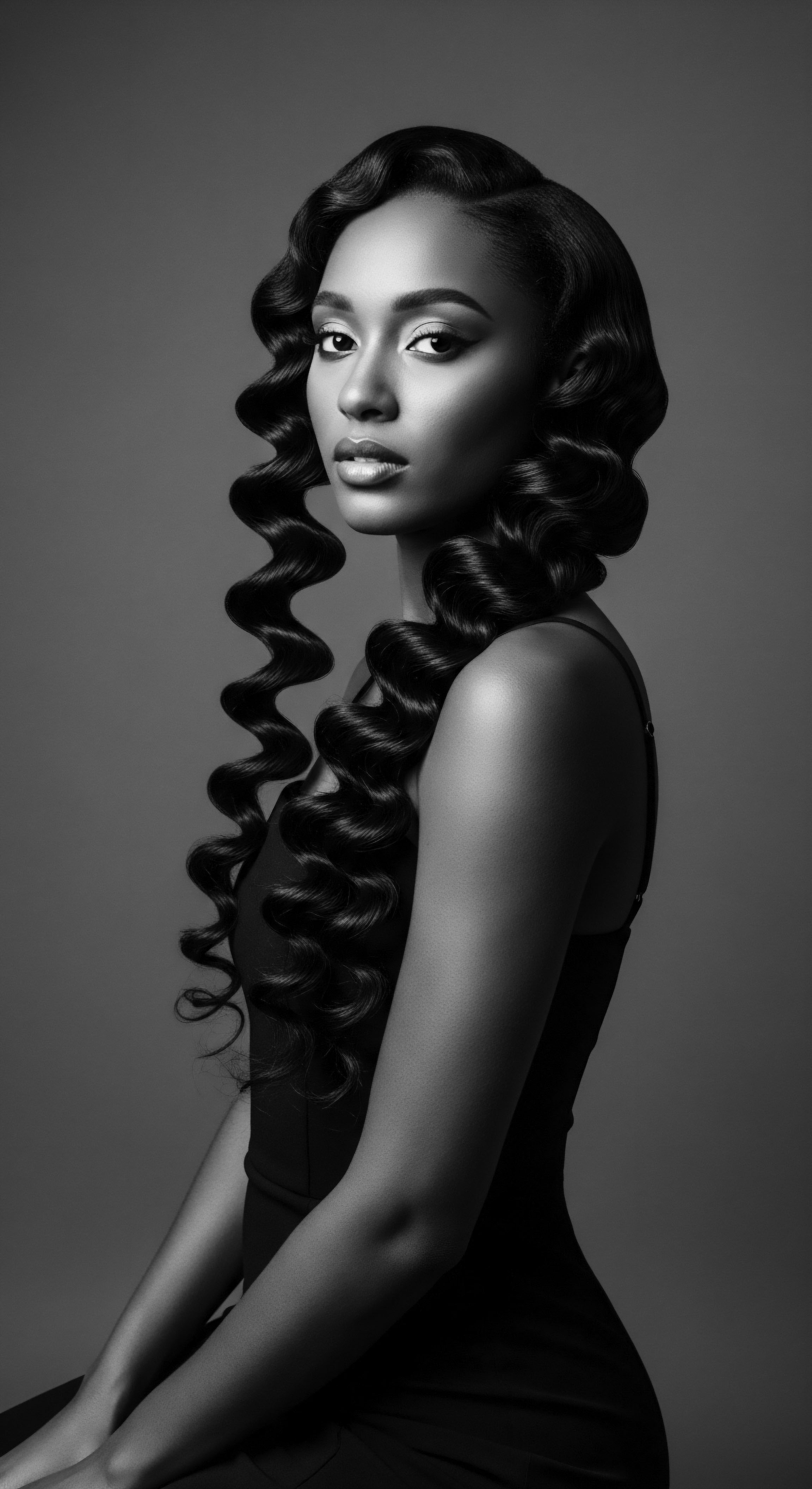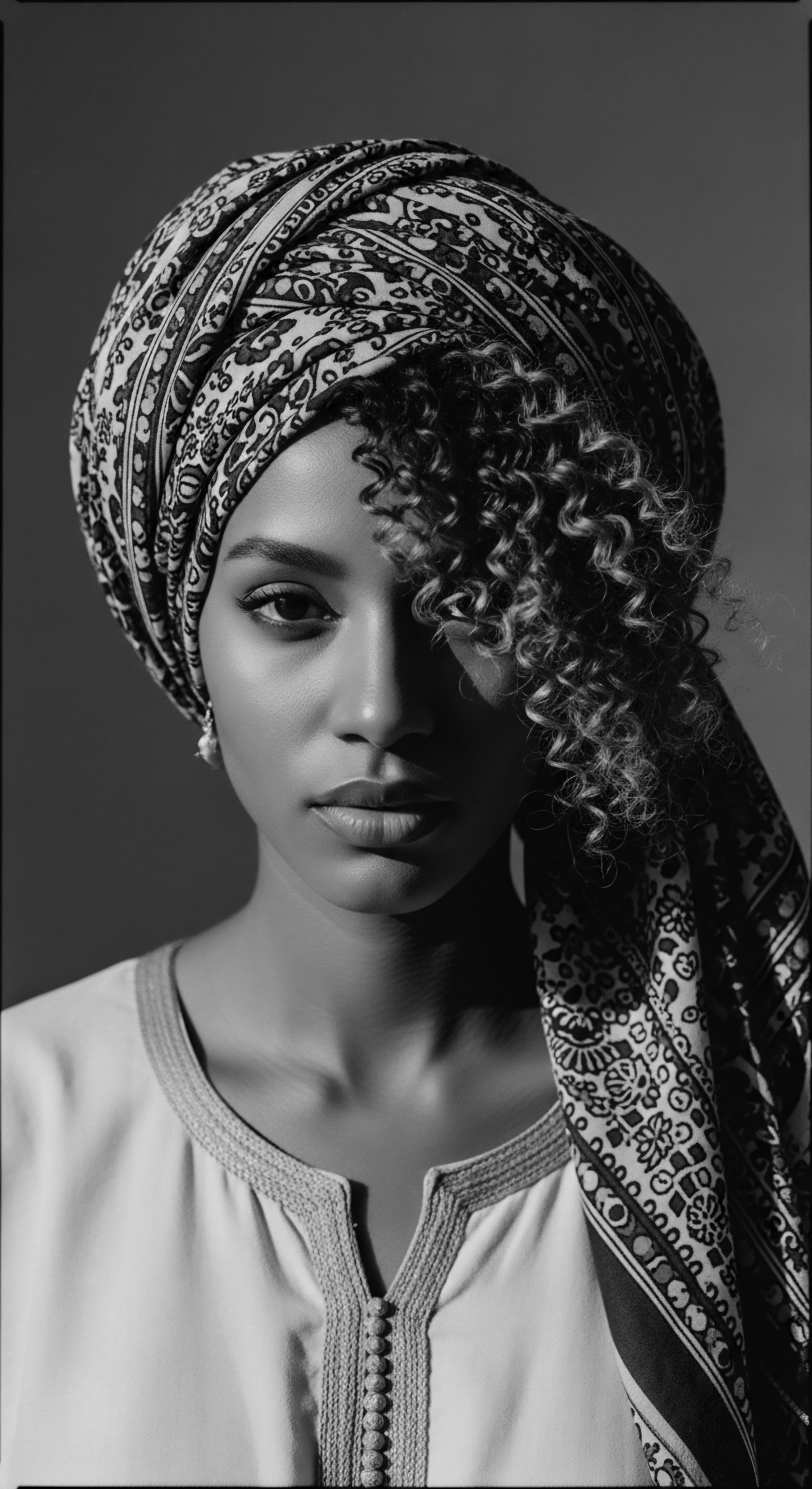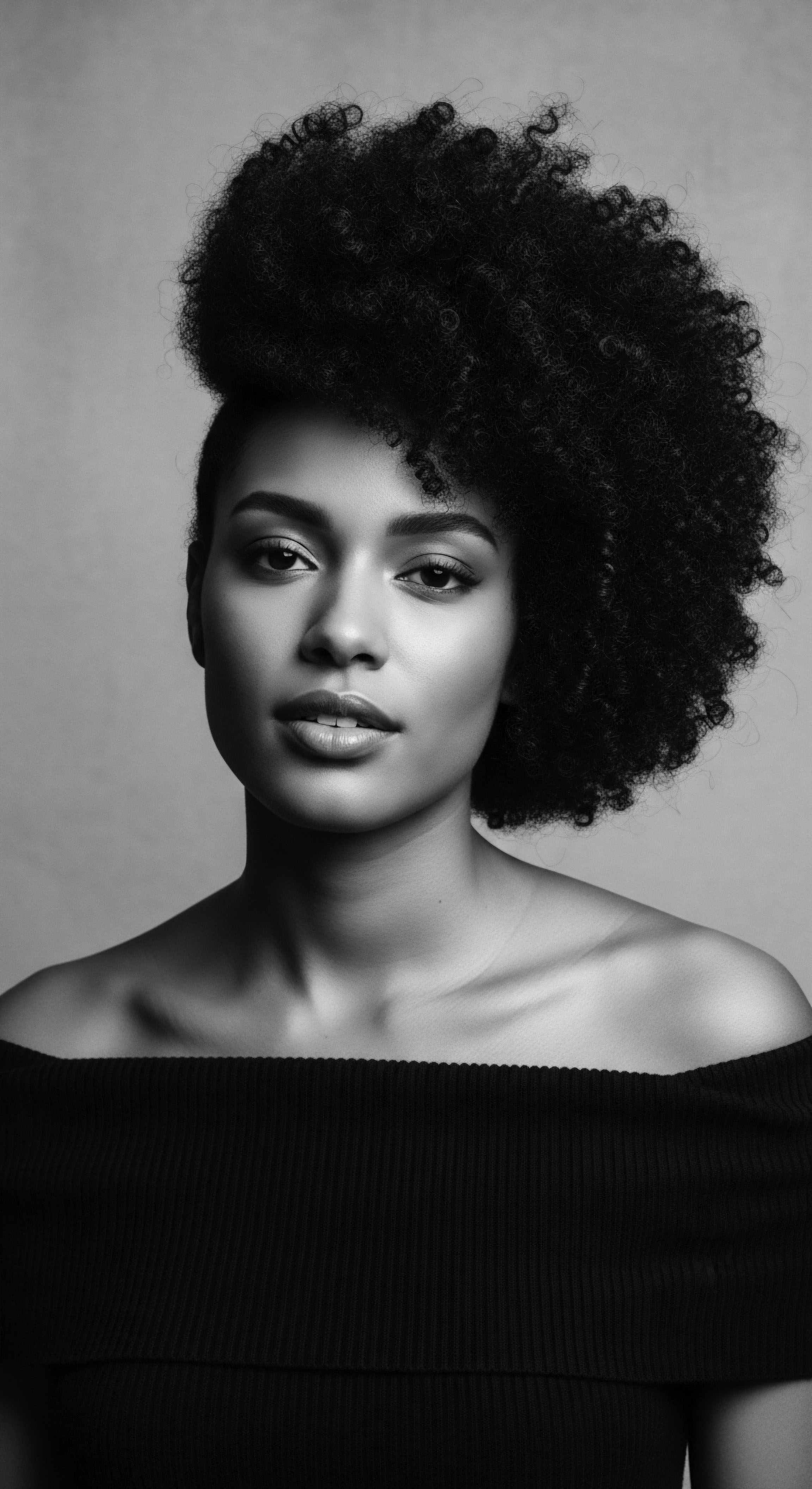
Fundamentals
Hair Keratin Synthesis, at its core, is the biological crafting of keratin, the fundamental protein that gives hair its form, resilience, and vitality. Imagine it as the intricate weaving of individual protein strands into the robust, protective fibers that constitute our hair. This process occurs within the hair follicles, those tiny, yet powerful, structures nestled beneath the scalp.
Keratin is a fibrous, structural protein and the main building block of human hair, also found in nails and the skin’s outer layer. It’s a protective protein, insoluble in water, and notably less prone to scratching or tearing than other cells our bodies create.
There exist two principal categories of keratin ❉ Alpha-Keratin and Beta-Keratin. Alpha-keratin, relevant to human hair, possesses a coiled, helical structure that provides hair with its characteristic flexibility and “give” when stretched. Beta-keratin, in contrast, is found in the harder, more rigid structures of other living beings, like the beaks of birds or the horns of certain animals.
In the human body, approximately 54 distinct kinds of keratin exist, with 11 specifically categorized as hair keratins. The production of healthy, vibrant hair hinges upon the proper synthesis of this remarkable protein, a process deeply sensitive to various internal and external factors.
Understanding the meaning of keratin synthesis also helps to clarify why hair possesses its strength and durability. The hair shaft is almost entirely protein, composed mainly of keratin. This protein forms a protective coating on the hair shaft, making it more resilient. However, this coating can diminish with exposure to harsh environmental factors, heat styling, and certain products, leading to damage, dryness, and breakage.
Hair Keratin Synthesis is the intricate biological process through which our hair is built from keratin proteins, conferring its unique structure and inherent strength.
The synthesis of keratin is a continuous cycle, an ongoing testament to the body’s innate ability to replenish and renew. It begins with the transcription of keratin genes into messenger RNA within the hair follicles’ keratinocytes, the very cells dedicated to producing this protein. These keratin proteins then assemble into intermediate filaments, forming progressively larger fibers that constitute the bulk of the hair fiber, known as the cortex. Encircling this core is the cuticle, a protective layer of overlapping, dead cells.

The Genesis of Hair ❉ A Natural Wonder
The journey of a single strand begins in the hair follicle, a complex structure that serves as its birthplace. Within this follicle, specialized cells known as Keratinocytes diligently produce keratin proteins. These proteins then link together, forming strong bonds that determine the hair’s eventual shape and texture.
The hair follicle’s shape plays a crucial role in this process; round follicles tend to produce straight hair, while more oval or flattened follicles yield wavy or curly hair. This initial formation is a marvel of natural engineering, deeply intertwined with our ancestral blueprint.
- Protein Power ❉ Hair is predominantly composed of protein, and specifically keratin. The adequacy of protein in one’s diet is therefore fundamental for the production of healthy hair.
- The Role of Biotin ❉ Biotin, a B vitamin often recognized for its influence on hair, plays a significant part in keratin production, contributing to hair elasticity and overall strength. Eggs, nuts, and sweet potatoes are noted sources of biotin.
- Vitamins and Minerals ❉ Essential vitamins and minerals are vital for the biosynthetic and energetic metabolism of the hair follicle. For instance, zinc supports the reproduction of keratinocytes, the cells that produce keratin, and Vitamin A is also essential for keratin synthesis.

Intermediate
Beyond the fundamental understanding, Hair Keratin Synthesis presents itself as a sophisticated biological architecture, a testament to the body’s profound ingenuity. It describes the meticulous orchestration of various protein components and cellular processes that collectively construct the hair fiber, giving it its unique physical attributes. The meaning of this synthesis extends to its direct influence on the morphological characteristics of hair, ranging from its diameter and form to its overall cross-section. This intricate arrangement is what determines the tactile and visual qualities that are so deeply connected to personal and cultural identity, particularly within textured hair communities.
The formation of keratin involves the precise alignment of two types of keratin polypeptides ❉ acidic Type I Keratins and neutral-basic Type II Keratins. These types pair in equal amounts to create heterodimers, which subsequently aggregate into higher-order structural units known as intermediate filaments. These intermediate filaments then bundle to form macro-fibrils, making up the bulk of the hair’s cortex. This carefully choreographed assembly, from amino acid sequences to the final, healthy strand, can be disrupted by various human interventions and environmental exposures.
Hair Keratin Synthesis is a complex biochemical dance, where specific proteins align and bond, shaping each strand’s curl, strength, and inherent character.
Moreover, genetic factors hold a significant sway over the Hair Keratin Synthesis process, dictating the shape of the hair follicle and the distribution of disulfide bonds within keratin. These disulfide bonds, formed when sulfur atoms within keratin link, profoundly influence hair shape and texture. The more hooked the hair follicle and the greater the number of disulfide bonds, the curlier the hair tends to be.

Echoes from the Source ❉ Ancestral Wisdom in Hair Care
For generations, ancestral practices in Black and mixed-race communities have instinctively supported the very processes we now understand as Hair Keratin Synthesis, long before scientific nomenclature existed. These traditions, rooted in the understanding that hair is a vital part of self and heritage, often revolved around natural ingredients that provided the essential building blocks for hair health. These practices, passed down through the ages, included careful cleansing, diligent moisturizing, and protective styling methods.
One particularly resonant example of ancestral knowledge supporting robust Hair Keratin Synthesis comes from the rice farmers of West Africa, during the harrowing period of the transatlantic slave trade. As enslaved individuals were forcibly transported to the Americas, African women, specifically those with backgrounds in rice farming, braided rice seeds into their hair as a profound act of resistance and a means of survival. This practice, documented by organizations like BLAM UK CIC and the African American Museum of Iowa, served not only to preserve a vital food source but also to carry a piece of their homeland and culture, a silent testament to enduring heritage.
The nutritional benefits of rice, a staple rich in carbohydrates and some proteins, would have contributed to the overall health and growth of hair in a subtle, sustained way, complementing the body’s inherent keratin production, even in the most challenging circumstances. This practice, while not directly about the chemical process of keratin synthesis, powerfully underscores the deep historical connection between careful resource management, ancestral knowledge of plant properties, and the support of hair vitality through nutrition—a silent validation of the building blocks our bodies require.
This historical example illustrates that traditional hair care was never a mere aesthetic pursuit; it was intertwined with survival, identity, and the spiritual well-being of the community. The reverence for hair in many African societies meant that practices supporting its strength and vitality, inherently tied to keratin, were deeply embedded in daily life.
| Ancestral Practice Regular Cleansing with Natural Ingredients (e.g. yucca root) |
| Potential Keratin Synthesis Benefit Maintains scalp health, enabling efficient nutrient delivery to follicles for keratin production. |
| Ancestral Practice Oiling and Greasing with Shea Butter, Coconut Oil, Animal Fats |
| Potential Keratin Synthesis Benefit Protects hair shaft, reduces breakage, and supports cuticle integrity, preserving existing keratin structure. |
| Ancestral Practice Protective Styles (Braids, Twists, Locs) |
| Potential Keratin Synthesis Benefit Minimizes mechanical stress and environmental exposure, safeguarding keratin bonds and reducing damage. |
| Ancestral Practice Nutrient-Rich Diets (Implicit through historical examples) |
| Potential Keratin Synthesis Benefit Provides amino acids, vitamins, and minerals essential for the body's internal keratin production. |
| Ancestral Practice These traditions, often passed down through generations, demonstrate an intuitive understanding of hair’s needs for strength and health, long before modern scientific inquiry into keratin. |

Academic
Hair Keratin Synthesis represents the highly regulated, multi-step cellular and molecular biological pathway through which the hair follicle synthesizes and organizes keratin proteins into the robust, filamentous structures that comprise the hair shaft. This encompasses the precise gene expression, protein folding, assembly of intermediate filaments, and subsequent cross-linking that together determine the hair fiber’s mechanical properties, morphology, and overall resilience. The meaning extends to the intricate interplay of genetic predispositions, nutritional inputs, and cellular signaling within the follicular unit, which collectively dictate the efficiency and quality of keratin production, profoundly influencing hair phenotype, particularly within diverse textured hair populations.
At the sub-cellular level, the genesis of hair keratin commences with the transcription of specific Keratin Genes (KRT) into messenger RNA within the cortical keratinocytes of the hair matrix. Humans possess approximately 54 keratin genes, half of which contribute to hair and other hard keratinizing tissues. These are broadly categorized into Type I (acidic) and Type II (neutral-basic) keratins. The initial, critical step involves the stoichiometric pairing of one Type I and one Type II keratin polypeptide to form a Heterodimer.
These heterodimers subsequently align in an antiparallel manner to form tetramers, which then aggregate to create protofilaments. These protofilaments, in turn, assemble into Intermediate Filaments (IFs) of approximately 7.5 nm diameter.
The hierarchical arrangement continues as these IFs are embedded within a matrix composed of Keratin-Associated Proteins (KAPs), which are either rich in cysteine or glycine-tyrosine. KAPs play a crucial role in cross-linking the keratin filaments into rigid structures, thereby conferring mechanical strength to the hair follicle and shaft. This matrix and IF assembly is then insolubilized through the oxidative formation of numerous Disulfide Bonds between cysteine residues within both keratin and KAP proteins.
The density and precise positioning of these disulfide bonds are paramount in dictating the hair’s tertiary structure and its macroscopic curl pattern. For instance, a higher density of disulfide bonds and specific follicle shapes contribute to the tight coiling characteristic of many textured hair types.
Beyond the structural components, regulatory proteins also exert significant influence. Trichohyalin (TCHH), for example, is a multifunctional protein expressed in the inner root sheath (IRS) and medulla of the hair, directly involved in cross-linking keratin filaments and providing mechanical strength to the hair follicles. Polymorphic variations in TCHH are strongly associated with curly hair phenotypes across different populations. This is particularly salient for understanding the inherent structure of textured hair, where these genetic influences are often more pronounced, guiding the distinctive spiral growth of the fiber.
The academic meaning of Hair Keratin Synthesis delves into the precise genetic, cellular, and biochemical mechanisms that construct hair, with specific attention to how these processes orchestrate the diverse morphologies seen in textured hair.
Consider a study by Westgate et al. (2017) which highlights significant links between polymorphic variation in trichohyalin, a copper transporter protein (CUTC), and the inner root sheath component keratin 74 (KRT74) with curly hair phenotypes in a South African population. KRT74, expressed in Huxley’s layer of the IRS, influences the mechanical forces the IRS exerts on the nascent hair shaft, thereby contributing to curl formation.
This genomic insight, revealing that curly hair is a complex trait influenced by multiple genes rather than a single Mendelian factor, deepens our understanding of the inherent biological diversity within textured hair. It affirms that the very architecture of curls is a genetic masterpiece, not merely a stylistic choice.

Biochemical Interconnections and External Influences
The fidelity of Hair Keratin Synthesis is profoundly influenced by systemic nutritional status. Hair follicles, characterized by high biosynthetic activity, demand a continuous supply of proteins, calories, trace elements, and vitamins. Dietary protein is particularly critical given the hair shaft’s composition of almost entirely keratin.
Deficiencies in key micronutrients such as biotin, iron, and zinc can directly impede keratin production and hair growth. Biotin assists in metabolizing the amino acids necessary for keratin creation, while zinc supports the reproduction of keratinocytes.
Moreover, chemical treatments, a common aspect of hair care in many communities, profoundly affect the integrity of synthesized keratin. Processes like chemical relaxers operate by breaking the disulfide bonds within the keratin structure, altering the hair’s natural curl pattern. While these treatments aim to reshape the hair, they can also lead to an incomplete re-oxidation of newly formed disulfide bonds, potentially compromising the hair’s inherent strength and elasticity. This is particularly relevant in the context of Black and mixed-race hair experiences, where the historical pressure to conform to Eurocentric beauty standards often led to the widespread use of chemical straighteners, with documented adverse health implications associated with certain chemicals.
- Gene Expression and Regulation ❉ The synthesis of keratin begins with the specific genes that encode for various keratin types (KRTs) and keratin-associated proteins (KAPs), which are then expressed in the hair follicle. The balance and specific types of these gene products ultimately dictate the rigidity and elasticity of the hair fiber.
- Follicular Morphology ❉ The precise geometry of the hair follicle—whether it is round, oval, or elliptical—plays a determinative role in shaping the hair shaft as it grows. This morphology influences the internal organization of keratin filaments and disulfide bond distribution, thereby defining curl pattern.
- Disulfide Bond Dynamics ❉ The formation and arrangement of disulfide bonds between cysteine residues within keratin proteins and KAPs are paramount to the hair’s structural integrity and shape. These covalent bonds provide significant strength and are the target of chemical treatments designed to alter hair texture.
- Nutritional Substrate Availability ❉ Adequate dietary intake of amino acids (the building blocks of proteins), vitamins (especially B-vitamins like biotin, and Vitamin A), and trace elements (like zinc and iron) are indispensable for the efficient synthesis of keratin and overall hair health.
The academic lens on Hair Keratin Synthesis provides a crucial framework for understanding not only the biological marvel of hair itself but also the historical and cultural choices made in its care. The exploration of its intricate mechanisms allows us to truly appreciate the resilience of textured hair, and the profound wisdom embedded within ancestral hair care practices that often, perhaps unknowingly, optimized the very conditions necessary for its healthy formation.

Reflection on the Heritage of Hair Keratin Synthesis
The journey through the Hair Keratin Synthesis, from its elemental biological roots to its complex cultural implications, offers a profound meditation on textured hair, its enduring heritage, and its nuanced care. It becomes clear that hair is not a mere biological appendage; it is a living archive, each strand carrying the echoes of ancestral wisdom, resilience, and identity. The understanding of keratin’s role, from the molecular bonds that create a coil to the nutritional inputs that sustain it, allows for a deeper reverence for hair’s inherent design.
Throughout history, Black and mixed-race communities, through their inherited practices and innovations, have intuitively tended to their hair in ways that, while not always scientifically articulated at the time, inherently supported the principles of keratin health. The act of braiding, oiling, and adorning hair was not just about appearance; it was about nurturing the physical structure of the hair while simultaneously fortifying cultural bonds and spiritual connections. The deep respect for hair, seen as a conduit to spiritual energy in many African cultures, informed a holistic approach to care that often safeguarded the very protein structures we now analyze in laboratories.
The story of Hair Keratin Synthesis, when viewed through the lens of heritage, transcends simple biology. It becomes a testament to the adaptive genius of humanity, a narrative woven with threads of survival, protest, and celebration. Recognizing the scientific underpinning of hair’s architecture empowers us to honor these traditions with newfound appreciation, understanding that the ancestral hand that applied shea butter or braided intricate patterns was, in essence, contributing to the very strength and integrity of the keratin within each strand.
This knowledge invites us to consider our hair care choices today as a continuation of a sacred lineage, where modern science meets timeless wisdom. It encourages a care ritual that fosters not just physical health but also a profound connection to the rich tapestry of human hair history, especially for those whose hair has been a visible emblem of their journey through time and across continents. Our hair, with its inherent keratin structure, stands as a symbol of unbroken lineage, a vibrant, living testament to the past that continues to shape our present and influence our future.

References
- Cleveland Clinic. (2022). Keratin ❉ Protein, Structure, Benefits, Uses & Risks.
- BLAM UK CIC. (2022). The History of Black Hair.
- African American Museum of Iowa. The History of Hair.
- Dunn, T. L. (2023). What Every Dermatologist Must Know About the History of Black Hair.
- Westgate, G. E. et al. (2020). The Genomic Variation in Textured Hair ❉ Implications in Developing a Holistic Hair Care Routine. MDPI.
- Keratin. (n.d.). Wikipedia.
- Salford Students’ Union. (2024). The Remarkable History Behind Black Hairstyles.
- Hair keratin. (n.d.). Wikipedia.
- Rushton, D. H. (2002). “Let Food be Thy Medicine” ❉ Value of Nutritional Treatment for Hair Loss.
- Keratin.com. (2025). The Genetics of Curly Hair.
- Bailey, T. J. (2017). Black Women and Beauty Culture in 20th-Century America. Oxford Research Encyclopedia of American History.
- Afriklens. (2024). African Hairstyles ❉ Cultural Significance and Legacy.
- Kubala, J. (2024). Best Foods for Hair Growth ❉ What to Eat, Drink & Avoid. Healthline.
- Violavip.com. (2024). The Biochemistry of Keratin.
- Robbins, C. R. (2012). The structure of people’s hair.
- Noireônaturel. (n.d.). The History of Relaxing Frizzy Hair ❉ the Evolution of Hair Standards.
- Hair Free Hair Grow. (2024). The Role of Nutrition in Promoting Hair Health and Growth.
- Reddit. (2020). Sacred Hair.
- Philip Kingsley. (2020). UNDER THE MICROSCOPE ❉ Keratin – Hair Guide.
- CLOUD NINE. Understanding How Nutrition Impacts Hair Loss and Growth.
- Prose. (2020). The Evolution of Black Hair Care.
- Medical News Today. (2020). Keratin-rich foods and their benefits.
- Sister Sky. (2019). The Significance Of Hair In Native American Culture.
- Know Your Hairitage. (n.d.). Native American Culture & Beauty Traditions.
- BA Notes. (2023). The Diversity of Hair Characteristics Across Human Populations.
- DR-NTU. (2021). Understanding the biochemical properties of human hair keratins ❉ self‑assembly potential and cell response.
- Preprints.org. (2024). Curly Hair From Genes (GWAS) to Functional Genomics ❉ Wnt-Secreting and -Receiving Macrophages Orchestrate Hair Types. A Hypothesis with Functional Implications.
- Myavana. (2024). The Science Behind Hair Texture ❉ Unraveling the Mysteries.
- UVA ChemSciComm. (n.d.). Chemistry of Wellness ❉ Hair and Hair Care.
- krepublishers.com. (n.d.). Human Hair in Personal Identification and Documenting Drug and Substance Abuse.
- Lupine Publishers. (2019). Keratin.
- HaarWerk by Cenk Auth. (n.d.). Keratin ❉ The Secret To Hair Growth?
- Patterson, E. J. (2017). Changing the shape of hair with keratin peptides.
- Mati, N. (n.d.). Formation of the Natural Structural Hierarchy in Hair and Hair Care that Alters the Formation of α-Keratin.
- Kera Mane. (2024). The Benefits of Amino Acids in Keratin Treatments ❉ Strengthening and R.
